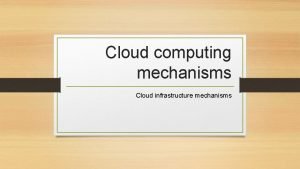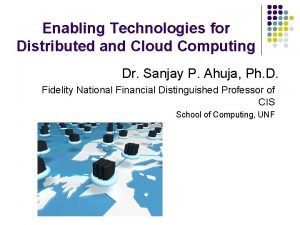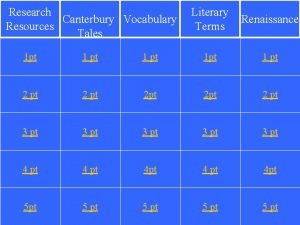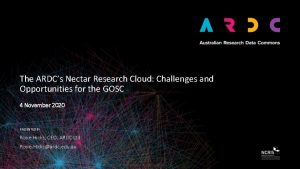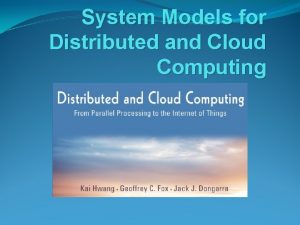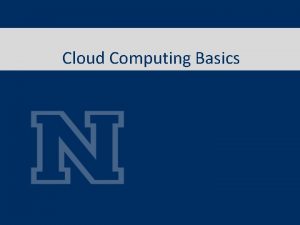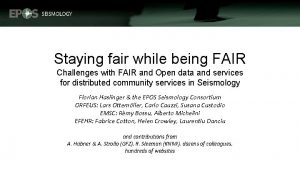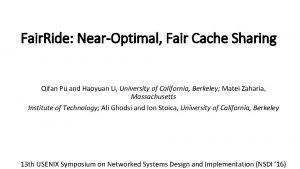Fair Cloud Sharing the Network in Cloud Computing



















![Reference • • • [1] Amazon web services. http: //aws. amazon. com. [2] M. Reference • • • [1] Amazon web services. http: //aws. amazon. com. [2] M.](https://slidetodoc.com/presentation_image_h/35c414a90562ae54030ad36b724470ff/image-20.jpg)

- Slides: 21

Fair. Cloud: Sharing the Network in Cloud Computing Computer Communication Review(2012) Arthur : Lucian Popa Arvind Krishnamurthy Sylvia Ratnasamy Ion Stoica Presenter : 段雲鵬

Outline • • • Introduction challenges sharing networks Properties for network sharing Mechanism Conclusion 2/20

Some concepts • Bisection bandwidth – Each node has a unit weight – Each link has a unit weight • Flow def – standard five-tuple in packet headers • B denotes bandwidth • T denotes traffic • W denotes the weight of a VM 3/20

Background • Resource in cloud computing – Network , CPU , memory • Network allocation – More difficult • Source, destination and cross traffic – Tradeoff • payment proportionality VS bandwidth guarantees 4/20

Introduction • Network allocation – Unkown to users , bad predictability • Fairness issues – Flows, source-destination pairs, or sources alone , destination alone • Difference with other resource – Interdependent Users – Interdependent Resources 5/20

Assumption • From a per-VM viewpoint • Be agnostic to VM placement and routing algorithms • In a single datacenter • Be largely orthogonal to work on network topologies to improve bisection bandwidth 6/20

Traditional Mechanism • Per flow fairness – Unfair when simply instantiating more flow • Per source-destination pair – Unfair when one VM communicates with more VMs • Per source – Unfair to destinations • Asymmetric – Only be fair for source or destination only 7/20

Examples • Per source-destination pair If there is little traffic on the A-F and B-E , B(A)=B(B) =B(E) =B(F) =2*B(C) =2*B(D) =B(G) =B(H) Per source B(E) =B(F) =0. 25*B(D) , In the opposite direction, B(A) =B(B) =0. 25*B(C) 8/20

Properties for network sharing(1) • Strategy proofness – Can’t increase bandwidth by modifying behavior at application level • Pareto Efficiency A – X and Y is bottlenecked , when B(X-Y) increases, B(A-B) must decrease , otherwise congestion will be worse A X 10 M B Y 1 M 10 M 9/20

Properties for network sharing(2) • Non-zero Flow Allocation – A strictly +B() between each pairs are expected • Independence L 1 – When T 2 increase , B 1 should not be affected • Symmetry – If all flows’ direction are swiched, the allocation should be the same L 2 Congested A e. g Not Congested 10/20 B

Network weight and user’s payment. • Weight Fidelity(provide incentive) – Strict Monotonicity (Monotonicity) • If W(VM) increases , then all its traffic must increase (not decrease). – Proportionality • Guaranteed Bandwidth Subset P(2/3) – Admission control • They are conflicting, tradeoff Subset Q(1/3) No communication between P and Q 11/20

Per Endpoint Sharing (PES) • Can explicitly trade between weight fidelity and guaranteed bandwidth – NA denote the number of VMs A is communicating with – WS-D=f(WS, WD) , WA-B=WB-A – Normalized by L 1 normalization • Drawback : Static Method (out of discussion) 12/20

Example • WA-D=WA/NA+WD/ND =1/2+1/2=1 • WA-C=WB-D=1/2+1/1=1. 5 • Total Weight=4(4 VMs) • So WA-D=1/4=0. 25 WA-C=WB-D=1. 5/4=0. 325 13/20

Comparison 14/20

PES • For one host , B ∝ (closer VMs) instead of (remote VMs) • Higher guarantees for the worst case • WA−B = WB−A =α*WA/NA+ β*WB/ NB – α and β can be designed to weight between bandwidth guarantees and weight fidelity 15/20

One Sided PES (OSPES) • Designed for tree-based topology • WA−B = WB−A =α*WA/NA+ β*WB/ NB • When closer to A, α = 1 and β = 0 • When closer to B, α = 0 and β = 1 16/20

OSPES • fair sharing for the traffic towards or from the tree root – Resource allocation are depended on the root When – Non-strict monotonicity W(A) = W(B) , If the access link is 1 Gbs, then each VM is guaranteed 500 Mbps WA-VM 1=1/1 WB-VMi=1/10(i=2, 3……, 11) 17/20

Max-Min Fairness • The minimum data rate that a dataflow achieves is maximized – The bottleneck is fully utilized • Can be applied 18/20

Conclusion • Problem : sharing the network within a cloud computing datacenter • Tradeoff between payment proportionality and bandwidth guarantees • A mechanism to make tradeoff between conflicting requirements 19/20
![Reference 1 Amazon web services http aws amazon com 2 M Reference • • • [1] Amazon web services. http: //aws. amazon. com. [2] M.](https://slidetodoc.com/presentation_image_h/35c414a90562ae54030ad36b724470ff/image-20.jpg)
Reference • • • [1] Amazon web services. http: //aws. amazon. com. [2] M. Al-Fares, A. Loukissas, and A. Vahdat. A scalable, commodity data center network architecture. In SIGCOMM. ACM, 2008. [3] M. Al-Fares, S. Radhakrishnan, B. Raghavan, N. Huang, and A. Vahdat. Hedera: Dynamic Flow Scheduling for Data Center Networks. In NSDI, 2010. [4] H. Ballani, P. Costa, T. Karagiannis, and A. Rowstron. Towards Predictable Datacenter Networks. In ACM SIGCOMM, 2011. [5] D. P. Bertsekas and R. Gallager. Data networks (2. ed. ). Prentice Hall, 1992. [6] B. Briscoe. Flow rate fairness: Dismantling a religion. ACM SIGCOMM • • Computer Communication Review, 2007. [7] N. G. Duffield, P. Goyal, A. G. Greenberg, P. P. Mishra, K. K. Ramakrishnan, and J. E. van der Merwe. A flexible model for resource management in virtual private networks. In SIGCOMM, 1999. [8] A. Ghodsi, M. Zaharia, B. Hindman, et al. Dominant resource fairness: fair allocation of multiple resource types. In USENIX NSDI, 2011. [9] A. Greenberg, J. R. Hamilton, N. Jain, S. Kandula, C. Kim, P. Lahiri, D. A. Maltz, P. Patel, and S. Sengupta. VL 2: A Scalable and Flexible Data Center

Thanks !! 21/20
 A composable component must be modular
A composable component must be modular Collaborating via social networks in cloud computing
Collaborating via social networks in cloud computing Logical network perimeter can
Logical network perimeter can Cloud computing network topology
Cloud computing network topology Intel to some cpu chips
Intel to some cpu chips Network centric computing
Network centric computing Sonnet 14 lines
Sonnet 14 lines Foul is fair and fair is foul literary device
Foul is fair and fair is foul literary device Macbeth literary devices examples
Macbeth literary devices examples Foul is fair and fair is foul
Foul is fair and fair is foul Syntax rhetorical device
Syntax rhetorical device Significato fair play
Significato fair play Examples of fair is foul and foul is fair in macbeth
Examples of fair is foul and foul is fair in macbeth Network sharing
Network sharing Conventional computing and intelligent computing
Conventional computing and intelligent computing Vodafone cloud solutions
Vodafone cloud solutions Hardware assisted virtualization in cloud computing
Hardware assisted virtualization in cloud computing Virtualization tools and mechanisms in cloud computing
Virtualization tools and mechanisms in cloud computing Type of cloud
Type of cloud Cloud computing reference model
Cloud computing reference model Ardc nectar
Ardc nectar Distributed system models in cloud computing
Distributed system models in cloud computing


